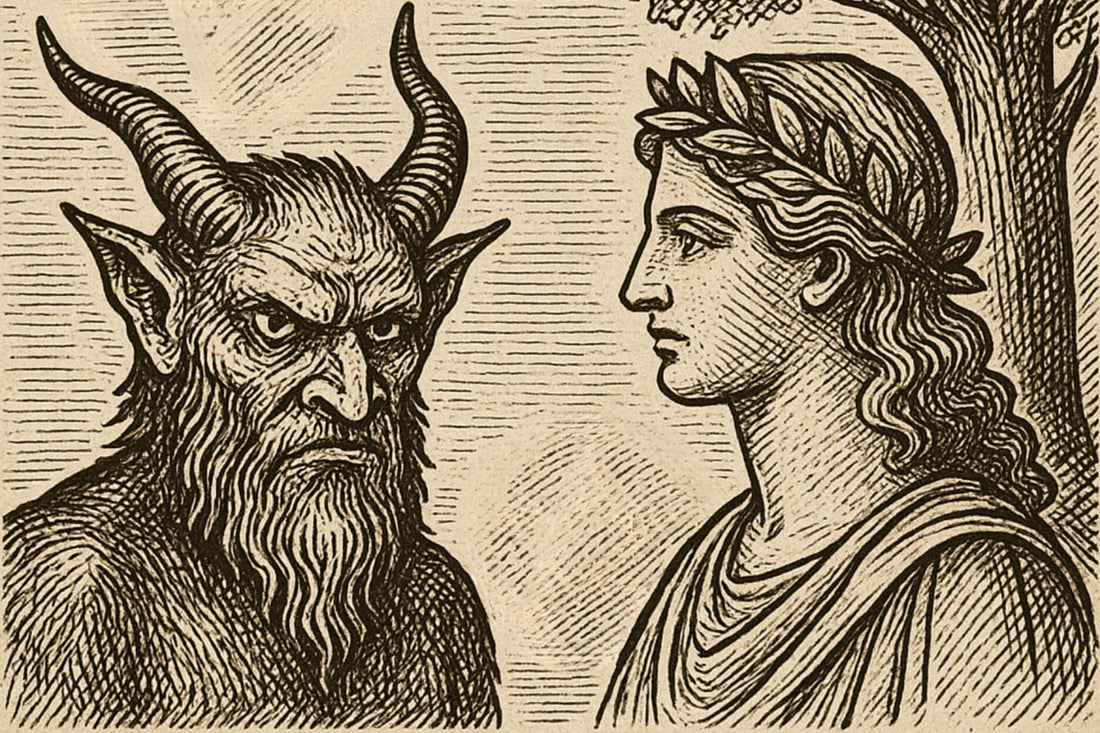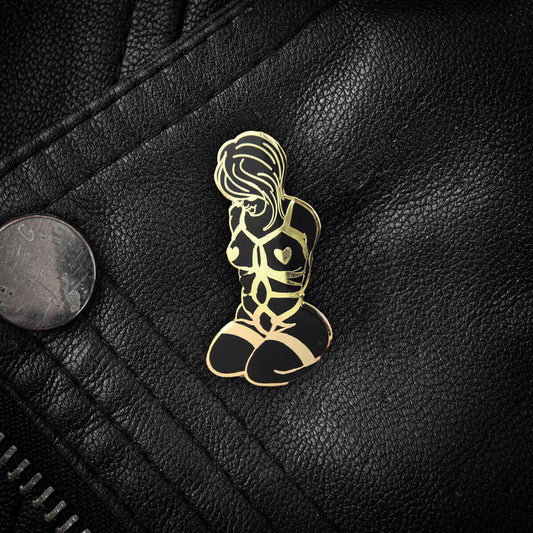
Satanism vs Paganism: How do they Differ?
Share
Satanism and Paganism are two belief systems that are often lumped together, usually by people who don’t understand either. They’ve both been targets of moral panic, misunderstood by the media, and wrongly accused of devil worship. But the truth is, they’re not the same. In fact, they come from entirely different roots, with different goals, values, and worldviews.
Satanism, especially in its modern forms, is largely a reaction to Christian dominance. Whether symbolic or spiritual, it often focuses on personal freedom, rebellion against religious authority, and the elevation of the individual. Most forms of Satanism don’t believe in God or Satan as literal beings.
Paganism, on the other hand, is usually a revival or reconstruction of pre-Christian religions. It tends to be nature focused, polytheistic, and steeped in ritual. Pagans honour deities that pre-date Christianity; gods like Odin, Brigid, Hecate, or Zeus, and celebrate the rhythms of the natural world.
This article will break down the differences and clear up common confusion. They might share enemies, but Satanism and Paganism are not two sides of the same coin. They’re two different currencies entirely.
Key Points
- Satanism and Paganism are entirely separate belief systems, with different origins, goals, and worldviews. Satanism is usually modern and symbolic; Paganism is often ancient or nature-based.
- Satanists don’t worship nature or deities - most focus on individual autonomy and reason. Pagans, by contrast, honour multiple gods and see nature as sacred.
- The two paths use ritual differently. Satanic rituals tend to be symbolic or psychological; Pagan rituals often aim to connect with divine forces and seasonal cycles.
- Paganism is typically more accepted legally and socially, while Satanism often sparks more controversy due to its name and confrontational stance toward mainstream religion.
- Despite the differences, both face public misconceptions, and both push back against religious authority and moral policing.

Some megaliths are believed to have religious significance • Public Domain, Link
Definitions and Origins
Despite often being lumped together in pop culture or church sermons, Satanism and Paganism have different historical roots, different purposes, and totally different relationships to religion.
What is Satanism?
Satanism, as a self-defined belief system, is a modern invention. The first organised group to openly call themselves Satanists was the Church of Satan, founded by Anton LaVey in 1966. LaVey's form of Satanism is atheistic. Satan is used as a symbol, not a deity for pride, personal power, and defiance against religious conformity.
Since then, other types have emerged. The Satanic Temple (TST), founded in 2013, focuses on political activism, separation of church and state, and social justice. Like LaVeyan Satanism, TST is non-theistic. In contrast, theistic Satanists believe in Satan as a real supernatural being and may revere or worship him in a spiritual sense. These groups are more fragmented and don’t follow a single text or leader.
Despite the differences between branches, Satanism as a whole tends to be individualistic, anti-authoritarian, and reactionary. It defines itself in opposition to dominant religious norms, especially Christianity.
What is Paganism?
Paganism is a much older concept - at least in origin. The word paganus was used by the early Christian church to describe rural folk who still practised pre-Christian religions. Today, Paganism refers to a broad range of polytheistic, nature-based spiritual paths, many of which aim to reconstruct or reimagine ancient beliefs.
Modern Paganism includes many strands:
- Wicca (a duotheistic or polytheistic tradition founded in the 20th century)
- Druidry (inspired by Celtic traditions)
- Hellenism, Norse Heathenry, Kemeticism, and other reconstructions of Greek, Norse, and Egyptian religions.
Unlike Satanism, Paganism isn’t about rebellion against Christianity-it’s about reviving older spiritual frameworks that were pushed out by Christianity in the first place. Many Pagans see their path as a return to ancestral ways, not a protest against modern religion.
The Differences in Beliefs and Worldview
While both Satanism and Paganism can fall under the broader category of alternative or non-mainstream religions, their core beliefs point in completely different directions. One tends to focus inward on the self; the other looks outward to nature, the gods, and the cycles of life.
The Spiritual Focus
Satanism, in most of its forms, is not centred on spiritual deities. LaVeyan Satanists and The Satanic Temple members typically don’t believe in gods, spirits, or an afterlife. Their focus is on the individual as the highest authority. Satan is a symbol – an archetype of defiance, critical thinking, and self-determination. Theistic Satanists are an exception, but they’re a minority. Even they often reject worship in the traditional sense, viewing Satan as a mentor or liberator rather than a ruler.
Paganism, on the other hand, is often deeply spiritual. Most Pagans believe in multiple gods or spirits, many of which are drawn from ancient mythologies. These deities are seen as real beings, or at least real aspects of nature, human psychology, or cosmic forces. Many Pagan traditions include rituals meant to connect with these gods, with ancestors, or with the natural world.
Ethics
Satanic ethics revolve around individual responsibility. LaVey promoted the idea of "eye for an eye" justice. The Satanic Temple takes a more humanistic approach, emphasising compassion, bodily autonomy, and scientific reasoning through its Seven Tenets. Across the board, Satanism avoids imposed moral codes. You are the master of your own ethics.
Pagan moral systems are often community based and ecological. Many Pagan traditions teach reverence for the Earth, respect for all living beings, and a duty to maintain balance. Some follow codes like the Wiccan Rede ("An it harm none, do what ye will") or a set of virtues linked to a specific culture or pantheon.
In short, Satanism often treats the self as sacred; Paganism treats the world as sacred. Both offer paths outside mainstream religion, but their perspectives on life, power, and meaning are shaped by entirely different assumptions.
Photo by Julia Arte on Unsplash
Rituals or Practices
Satanic and Pagan rituals might look similar on the surface: candles, symbols, robes, invocations. But they’re performed for very different reasons and follow different logic. One focuses on personal psychology or symbolism, while the other usually aims to honour gods, mark seasonal changes, or channel natural energies.
Satanic rituals, especially in LaVeyan practice, are often theatrical by design. They are not about calling on spirits or deities. Instead, they serve as controlled environments for emotional release, personal empowerment, or celebration. Think of them as psychodrama; rituals that use symbolism to shift internal states. Some include destruction rituals to let go of anger or resentment, compassion rituals to focus care or healing, or rites of indulgence. Even in theistic branches, rituals tend to centre on autonomy, power, and transformation rather than submission or worship in the traditional sense.
The Satanic Temple treats rituals as optional. When used, they are typically adapted to modern needs and grounded in symbolism. They're often used to build community or mark personal milestones.
Pagan rituals, by contrast, are usually spiritual at their core. They often involve calling on gods, goddesses, ancestors, or elemental forces. Many Pagan traditions have set calendar celebrations. The Wheel of the Year in Wicca includes eight sabbats like Samhain, Beltane, and the solstices, each tied to seasonal shifts. Rituals may include offerings to deities, chanting, dancing, lighting fires, or casting circles to create sacred space.
Magic is another key difference. In Satanism, magic (if used at all) is mostly symbolic or psychological. In Paganism, it is often taken more literally. It’s used for healing, divination, protection, or manifesting change. Many Pagans practise forms of folk magic, herbalism, or ceremonial spellcraft, believing they can influence the world through ritual and intention.
So while both groups might share an altar and a candle, the reason they’re lighting it can be completely different.
Their View on Nature
One of the biggest contrasts between Satanism and Paganism lies in how each relates to nature and divinity. These aren't just surface-level differences; they cut to the heart of how followers see the world and their place within it.
In most forms of Paganism, nature is sacred. The earth is not just a backdrop to spiritual life; it is the foundation of it. Many Pagans believe in animism-the idea that everything in nature has a spirit or energy. Trees, rivers, stones, animals, and even weather are often seen as having meaning or agency. The divine is usually found in the natural world. Some traditions see gods and goddesses as expressions of natural forces, like the sun, moon, or seasons. Others work with specific deities from historical pantheons but still root their practice in ecological awareness and seasonal cycles.
In Satanism, nature is usually respected but not spiritualised in the same way. LaVeyan Satanists often view the natural world through a materialist lens: beautiful, powerful, and deserving of appreciation, but not sacred. The natural order is sometimes used as a metaphor for strength, survival, or self-interest - ideas drawn from nature but filtered through human reasoning. The Satanic Temple also values science and empirical evidence, which tends to frame nature as something to understand rather than worship.
Theistic Satanists may have a more mystical view, seeing nature as part of a spiritual universe. Even then, reverence for nature is usually tied to symbolic or metaphysical concepts, not a belief in nature spirits or divine cycles.
In short, Paganism often sees humans as part of nature. Satanism tends to place the human mind above it. Both may care deeply about the environment or the physical world, but they do so from very different foundations.
What mistakes do people make about Pagan and Satanists?
Satanism and Paganism have both been targets of ignorance, religious hostility, and wild tabloid nonsense. They’ve been blurred together so often that many people still assume they’re basically the same thing. They’re not. Most of the overlap exists in the minds of their critics rather than in the belief systems themselves.
Mistake 1: Pagans worship Satan
This is probably the most persistent myth. In reality, Paganism predates Christianity. Its deities come from cultures that existed long before the biblical idea of Satan ever appeared. Gods like Pan or Cernunnos were later demonised by the Church because they represented wildness and sexuality. Over time, they were rebranded as "Satanic" to justify repression. But actual Satan worship plays no part in most Pagan paths.
Mistake 2: Satanists are just edgy Pagans
Some people assume Satanists are just trying to be provocative versions of Pagans. But Satanism has a very different motivation. It’s usually a direct response to Christian culture-especially its moral rules, authority structures, and fear-based narratives. Paganism, by contrast, is focused on cultural restoration, ancestral wisdom, and working with nature. The reasons people are drawn to each path aren’t the same.
Mistake 3: Both are part of the occult or black magic
While some Pagan and Satanic practices fall under the broad label of occultism, that’s not a given. Not all Pagans cast spells. Not all Satanists perform rituals. And neither group automatically practices "black magic"; a term that’s more about moral judgement than any actual technique.
Mistake 4: Both groups are dangerous or antisocial
Decades of horror films, Christian propaganda, and media hysteria have painted both Pagans and Satanists as threats. In reality, the vast majority are peaceful, law-abiding, and simply want the freedom to practise their beliefs without interference. If anything, both communities have done extensive work correcting public misconceptions and advocating for religious tolerance.
These myths keep getting recycled because they’re convenient. They make it easier to dismiss what people don’t understand. But they’re also outdated, and they say more about the people spreading them than about the beliefs themselves.
Social and Legal Status
Both Satanism and Paganism exist on the fringes of mainstream religion. But how they’re treated by institutions, governments, and the public can be surprisingly different, depending on where you are in the world - and which branch of each you're talking about.
Paganism tends to have a slightly easier time gaining formal recognition. In countries like the United Kingdom, the United States, and parts of Europe, Paganism is often classified as a religion under the law. Wiccan and Druid groups have been granted the right to perform marriages, establish chaplaincies, and hold religious festivals on protected grounds. Pagan groups have worked for decades to gain legitimacy, often framing their beliefs as spiritual, earth-based, and culturally rooted rather than threatening or subversive.
Satanism, on the other hand, is more complicated. It’s legally recognised in many places, especially where freedom of religion is protected, but it remains far more controversial. This is partly because the name "Satan" provokes fear and moral panic. The Church of Satan has existed for over half a century, and The Satanic Temple is a registered religious organisation in the United States, but public acceptance still lags behind legal recognition.
Groups like The Satanic Temple have gained visibility by challenging religious privilege in public institutions. For example, demanding equal access to government spaces if Christian monuments or prayers are allowed. These moves are usually met with outrage, despite being lawful. They expose how uncomfortable many societies still are with minority religions, especially those that challenge Christian dominance head-on.
Socially, Pagans are more likely to be misunderstood than feared. Satanists are more likely to be feared than understood. Both face prejudice, but the flavour of that prejudice is different. Paganism is often dismissed as silly or superstitious. Satanism is treated as dangerous or immoral. In truth, most practitioners of both are just asking for the same thing: the right to believe what they believe without being demonised for it.

Photo by RDNE Stock project: https://www.pexels.com/photo/sea-nature-sunny-fashion-6806605/
Overlap and Mutual Respect
Despite their differences, Satanism and Paganism aren’t always at odds. In fact, in certain circles, there’s a quiet respect between the two. Some people even draw from both traditions, blending elements in a way that fits their personal worldview.
There’s overlap in values. Both paths emphasise personal freedom, reject religious dogma, and promote self-determination. Many Pagans and Satanists are deeply critical of organised religion-especially when it imposes moral codes, interferes with bodily autonomy, or seeks political power. That shared resistance often creates common ground, even if the beliefs themselves remain distinct.
Some modern Pagans incorporate Satanic ideas into their practice, especially those who lean toward chaos magic or Left-Hand Path traditions. Likewise, some Satanists adopt rituals or symbols that originate from Pagan sources, either for their aesthetic power or historical weight. It’s not unusual to see someone identifying as both a Luciferian and a Pagan, or practising Wicca while drawing on Satanic philosophy for its focus on individualism.
Still, most groups keep their boundaries. The average Wiccan or Druid likely sees Satanism as a separate system, with different goals and symbols. And many Satanists see Paganism as too theistic, too focused on nature, or too ritual-heavy for their taste. These differences aren’t usually hostile; they’re just lines of distinction.
There are exceptions. Some Pagans strongly reject any association with Satanism, especially if they’re trying to gain mainstream acceptance or avoid being targeted by religious critics. And some Satanists look down on Pagan paths as overly spiritual or irrational. But in general, where the two intersect, the tone is more often respectful than antagonistic.
In online forums, interfaith events, and even shared legal campaigns, Pagan and Satanic voices sometimes stand side by side. Both know what it feels like to be misunderstood. And both know how to push back.














